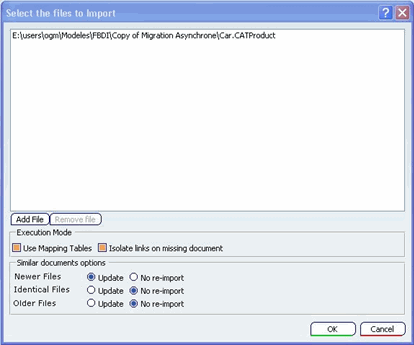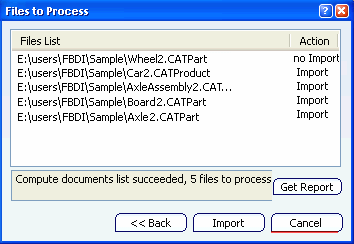Importing V5 Data by using Mapping Tables | ||
| ||
Importing V5 Data in Asynchronous Mode
This task describes how to import V5 Data in Asynchronous Mode.
![]()
Updating V6 Data Using Mapping Tables
This functionality is directly linked to the Asynchronous mode of FBDI as Mapping Tables as a prerequisite to identify the files already imported.
FBDI Coexistence
FBDI and CATDWC allow users to migrate their data back and forth between CATIA V5 and CATIA V6. Coexistence describes the combined use of these 2 process. This section describes scenarios and error messages associated with CATDWC-FBDI loop or V6 data -> V5 data -> V6 data exchange.
Any type of data processed by migration utility can be of 2 types:
- V5 Master
- V6 Master
This implies that there are some limitations on coexistence scenarios. Basically, a V5 Master data should not be modified on CATIA V6 and reciprocally. FBDI coexistence ensures that no CATIA data modification is accidentally overwritten by migration utilities.
If a file from CATDWC is imported and not referenced in Mapping Tables, FBDI fails to import the file and does not continue with the import process. The following error message is displayed,
Data you are trying to import has first been created on CATIA V6 session. However it is not referenced in the current mapping environment. It cannot be proceed by FBDI.
If CATIA V6 data that is modified in CATIA V5 and then imported, FBDI fails to import the file and does not continue with the import process.
The following error message is displayed,
Data you are trying to import have first been created on CATIA V6 session but has been later modified on CATIA V5. It is a conflicting situation. Current data as well as its pointed data will not be updated through FBDI.
If a CATIA V5 data pointing to data in the CATIA V6 master database is imported using No Import mode, the first time the file is imported in the 'Import' mode and in the 'Update' or 'No Import' mode after the initial import.
Note: If the CATDrawing data points to a removed feature of a 3dpart, the link is isolated.




